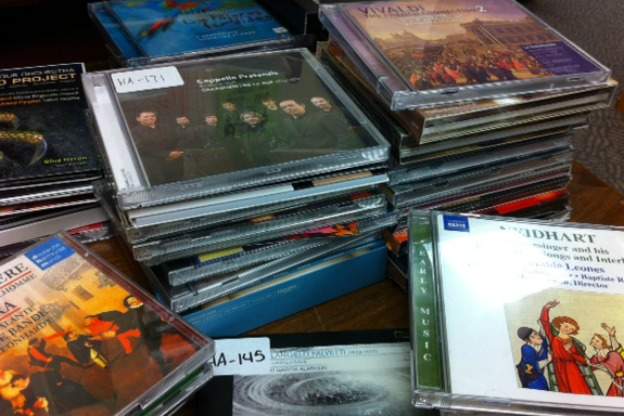
Time capsule for this episode: 1535
Ensemble Leones: Neidhart: A Minnesinger and his Vale of Tears
Despite several damaged pages, the Frankfurt Fragment, a manuscript dating from around the year 1300, preserves several texts and melodies of the poet-musician, Neidhart von Reuental, a famous Minnesinger. Ensemble Leones has recorded music from the manuscript in their 2012 release Neidhart: A Minnesinger and his Vale of Tears.
Neidhart seems to have enjoyed satirizing the classic Minnesang topics of duty, love, and loyalty. While starting out in earnest, his lyric poetry often takes an ironic turn after the first few verses. It’s possible that Neidhart accompanied his singing with instruments; among them would have been vielles, gitterns, lutes and bagpipes. Several instrumental pieces on this recording are improvised, compiled and arranged from Neidhart tunes and various contemporary melodies.
Cappella Pratensis: Ockeghem/de la Rue: Requiem
The requiems by Johannes Ockeghem and Pierre de la Rue are among the earliest known polyphonic examples of the genre. A 2012 recording by Dutch-based Cappella Pratensis offers performances of these two requiems.
Taken from the Chigi Manuscript, Ockeghem’s setting is striking in that it is notated by mostly 2- and 3-part writing with a maximum of four parts; however, it takes at least 6 voices to accommodate the various ranges for his writing. This characteristic has led some to wonder whether Ockeghem’s Requiem as it appears in the Chigi manuscript is actually a work in progress since others in the collection are obviously incomplete.
Pierre de la Rue was a generation younger than Ockeghem, but their Requiems were probably written about the same time. It is in some ways surprising to think that these polyphonic “masses for the dead” could have been composed at all, much less survive, since the medieval church had strict rules against musical adornment for rites of mourning at that time.
Cappella Mediterranea & Namur Chamber Choir: Il Diluvio Universale
A worldwide flood, a great seagoing vessel, and the man spared from it all…You guessed it…we’re talking about Noah and his ark. This catastrophic flood epic—set by 17th century Italian composer, Michelangelo Falvetti—depicts the destruction (purification) of all creation, humankind and animals, save Noah and those with him in the ark who are spared to repopulate the Earth.
In a performance of Falvetti’s Il Diluvio Universale, Cappella Mediterranea and the Namur Chamber Choir led by Leonardo Garcia Alarcón are joined by Iranian percussionist, Keyvan Chemirani. You can almost hear the raindrops begin to fall as Noah and his wife comfort one another in the face of the impending waters, and the chorus of humanity tries to escape in the midst of the storm.
La Serenissima: Vivaldi: The French Connection 2
Falvetti’s Il Diluvio Universale was first performed in 1682, when another Italian composer, Antonio Vivaldi, was about four years old.
Italian composers of Vivaldi’s generation were clearly interested in the French style, and the term “alla Francese” appears in several of his manuscripts. Seizing on this idea, all of the concerti on ensemble La Serenissima’s recent release have some association with France. One concerto was included simply because its manuscript version is written on French paper! Others were copied into a presentation set probably intended for a French nobleman. In the case of this bassoon concerto, La Serenissima finds the French flavor in the final movement, which Vivaldi casts un-usually in the form of a menuet en rondeau.
Featured recording: Lully/Mioliere: Le Bourgeois Gentilhomme
The Belgian ensemble, La Petite Bande was founded at the suggestion of the record company Deutsche Harmonia Mundi in order to make the 1973 recording we’re featuring today. The ensemble’s namesake, La Petite Band, is in fact what baroque composer Jean-Baptiste Lully called the orchestra he founded in France while in the service of King Louis XIV.
In 1670, Lully composed his Comédie-Ballet Le Bourgeois Gentilhomme. In 1973 the modern day La Petite Bande undertook its first project: a recording of Le Bourgeois Gentilhomme with the same instrumentation as Lully’s original band.
Many of the musicians heard on this recording are both formative and visionary in the field of early music. Among them include baroque violinists Sigiswald Kuijken and Lucy van Dael as well as Jordi Savall playing the cello(!) alongside Anner Bylsma, Weiland Kuijken and Richte van der Meer. Some, like oboist Bruce Haynes, and Gustav Leonhardt, who directed the orchestra for this recording, have recently passed away.
Autumn of 2012 marks this seminal ensemble’s 40th anniversary; in honor of this milestone, let’s hear from La Petite Bande’s very first recording.









